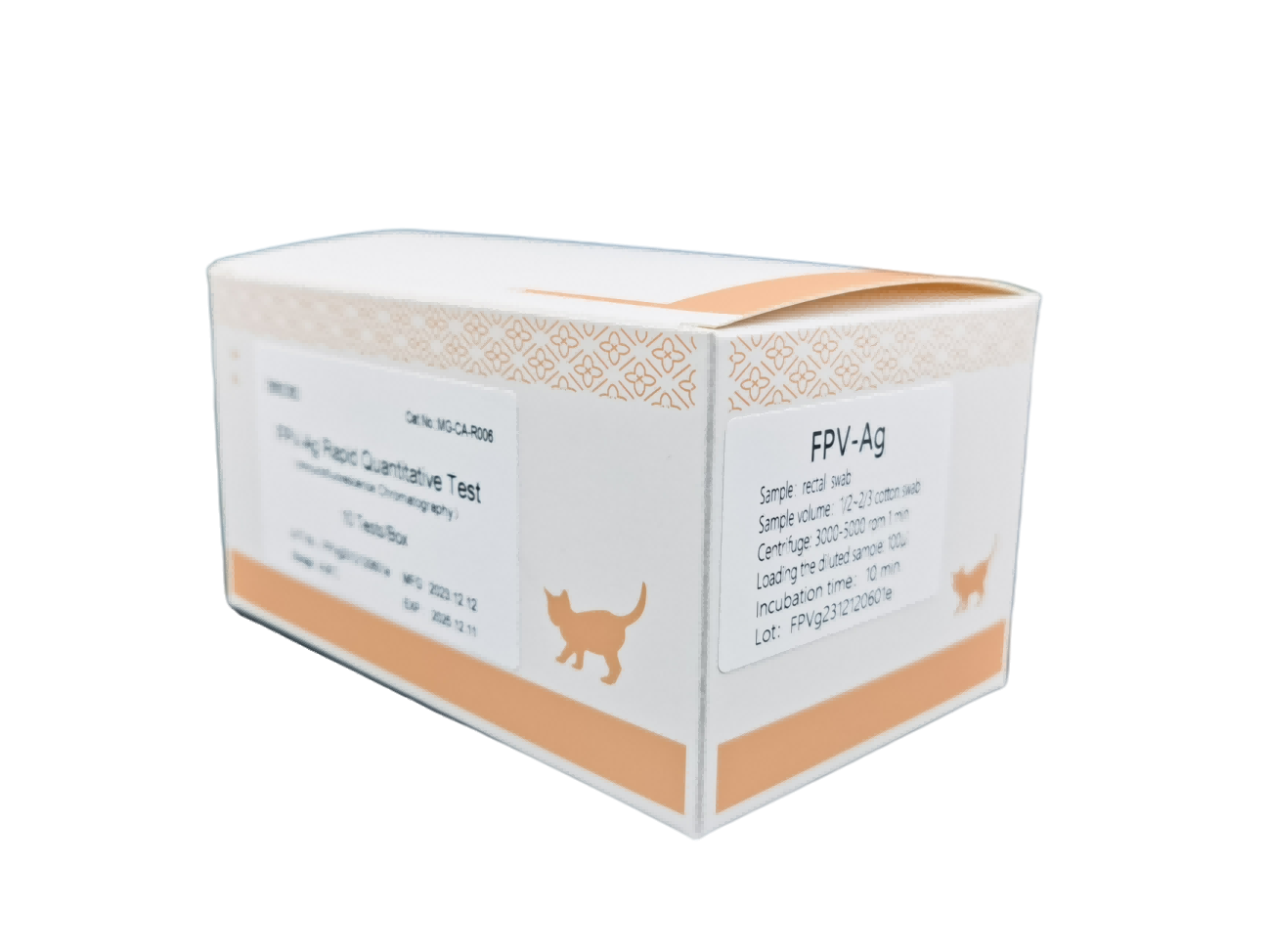



Key attributes

SPECIFICATION
10 Tests/Box
Catalog No.: MG-CA-R002
INTENDED USE
The fSAA test is a fluorescence immunoassay designed for use with an Immunofluorescence Analyzer to quantitatively determine feline serum amyloid A (fSAA) concentration in whole blood, serum, or plasma specimens. This test helps in confirming underlying inflammation and monitoring response to therapy, as well as post-operative effects and recovery.
For in vitro diagnostic use only. For professional use only.
TEST PRINCIPLE
This test uses a quantitative double antibody sandwich fluorescence immunoassay technique.
The intensity of the fluorescent signal reflects the amount of fSAA captured, with results expressed in mg/L.
MATERIALS PROVIDED
| Material Provided | Material Required But Not Provided |
|---|---|
| Each box contains: | |
| 1. 10 individual sealed pouches, each containing: | 1. Immunofluorescence Analyzer |
| – a Test Device | 2. Timer |
| – a desiccant pouch | 3. Pipette |
| 2. One ID Chip | 4. Centrifuge |
| 3. Instructions for Use | |
| 4. 10 tubes of fSAA Sample Buffer | |
| 5. 10 Pipette tips |
STORAGE AND STABILITY
Store the test kit at 4–30°C until the expiration date.
The test should be conducted at 18–28°C after opening the Test Device.
Perform the test within 30 minutes of opening the pouch.
SPECIMEN COLLECTION AND PREPARATION
The test can be performed with serum, plasma, or whole blood, though serum or plasma is recommended.
Collect whole blood into an EDTA anticoagulant tube by venipuncture, or separate serum or plasma from blood within 3 hours of collection. If the specimen is severely hemolyzed, a new specimen should be obtained.
Ideally, perform the test immediately after specimen collection. If testing cannot be done within 3 hours, store the specimen at 2–8°C for up to 72 hours. For long-term storage, freeze the specimen below -20°C.
Bring all materials to room temperature before use. Thaw frozen specimens completely and mix well prior to testing. Avoid repeated freezing and thawing. Use only clear, non-hemolyzed specimens.
TEST PROCEDURE
Refer to the Immunofluorescence Analyzer Operation Manual for complete instructions on using the Test Device.
Place the Test Device on a clean, level surface.
Insert the ID Chip into the meter and select "Read ID chip" to ensure the Test Device lot number matches the ID Chip number.
Pipette 10 μl of the prepared sample into the fSAA Sample Buffer and gently mix. Avoid vigorous agitation and foaming.
Pipette 100 μl of the mixed sample into the sample well of the Test Device, avoiding bubbles.
Test Mode Options:
a) Standard Test: Select "Standard Test," insert the Test Device into the meter holder immediately after adding the sample, and click "Start Test." Select sample type "Whole Blood" or "Serum/Plasma." The meter will count down and automatically read the result.
b) Quick Test: Select "Quick Test," start the timer immediately after adding the sample, and leave the Test Device at room temperature (18–28°C) for 3 minutes. Then insert the device into the meter holder and click "Start Test." Select sample type "Whole Blood" or "Serum/Plasma." The meter will automatically scan the Test Device and display the result.
Results will be shown on the main screen, printed automatically, or can be printed by clicking "Print."
QUALITY CONTROL
Each fSAA Rapid Quantitative Test includes an internal control for quality assurance. This control is run with each patient sample test. If an invalid result occurs, the meter will display an error message, indicating that a retest is necessary.
INTERPRETATION
Reference Range of fSAA in Feline Serum, Plasma, or Whole Blood:
Detection Range: 5–300 mg/L
Reference Range:
| Result (mg/L) | Interpretation |
|---|---|
| ≤ 10 | Normal (-) |
| 10–30 | Mild Inflammation (+) |
| 30–100 | Moderate Inflammation (++) |
| > 100 | Serious Inflammation (+++) |
Each laboratory should establish a reference range appropriate for the population being tested.
WARNINGS AND LIMITATIONS OF THE PROCEDURE
This kit is for in vitro diagnostic use only.
Inspect packaging and labels before use. Do not use if the pouch is damaged or the vial is leaking.
Do not use the test device after its expiration date.
Use a new pipette tip for each specimen to avoid contamination.
Technical or procedural errors and additional substances in blood specimens not listed in the instructions may interfere with the test and lead to erroneous results.
